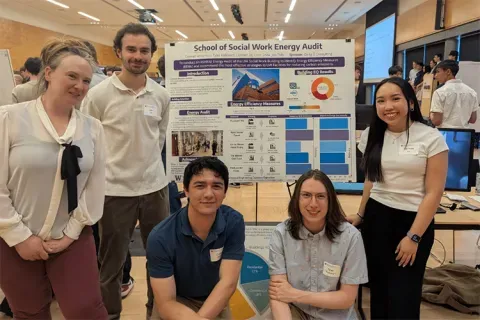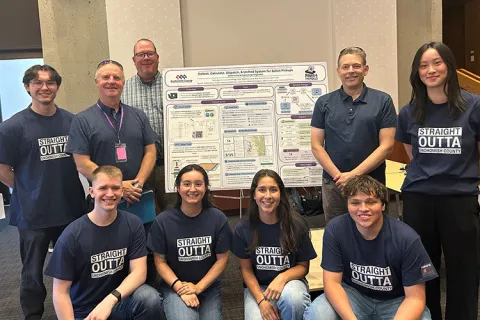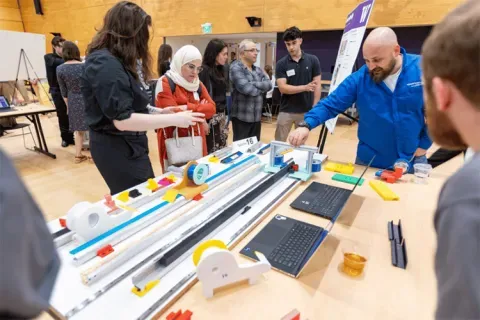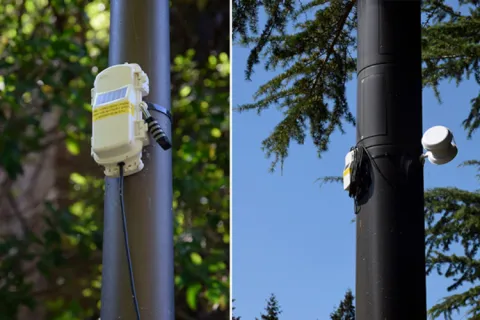Boeing
Sustainable Surface Layer Removal to Enable Recycling
Usage of carbon fiber composites in airplanes improves product sustainability by increasing durability, reducing weight, enabling part life extension, and improving producibility. However, the disposal of end-of-service composites has emerged as a pressing environmental challenge. While there are methods to recycle the carbon fiber reinforced polymer material by itself, current technology gaps prevent recycling feasibility of the end-of-service mixed material. One of the challenges hindering the effectiveness of recycling processes is the presence of surface layers, such as coatings and adhesives. This student team will work to conduct research, identify potentially efficient methods, and experiment with those methods (time and lab resources permitting) for the removal of process-limiting surface layers during end-of-life carbon fiber recycling. The objectives this student team will work to accomplish include: identifying and exploring innovative techniques that can safely and efficiently remove these surface layers, enabling enhanced recycling efficiency and promoting sustainable practices. Additionally, this student team will work to identify potential use cases for the byproducts generated from surface layer removal, thus promoting the circular economy. The outcomes this student team is working toward will potentially contribute to enhanced recycling efficiency, sustainability, and overall reduction of the environmental impact associated with end-of-life carbon fiber composites. This student team will work to address the following research questions: 1. What are the different types of surface layers commonly found on end-of-life carbon fiber composites? 2. How could these surface layers impact the efficiency of existing carbon fiber recycling processes? 3. What are the existing methods and techniques used for removal of similar finishes and surface layers during production, maintenance or other recycling industries? 4. Can novel approaches be developed or adapted from question 3 to improve the efficiency and effectiveness of surface layer removal? 5. How can the removed surface layers be properly handled, reused, recycled, or safely disposed? Methodology: 1) This student team will work to conduct a literature review and available case study Analysis. The student team will work to conduct an extensive review of existing literature and research papers to gather insights into the types and characteristics of surface layers, their impact on recycling, and existing removal methods. Additionally, this student team will work to review case studies of existing recycling facilities to gather real-world data on the effectiveness of current surface layer removal techniques. 2) This student team will work to collect expert interviews and surveys. This student team will work to interview industry experts and stakeholders internal to Boeing and throughout supply chain collecting insights and inputs to further advise characterization, process availability, existing removal methods, etc. This student team will also work to design and administer surveys to gather data from industry experts, researchers, and recycling practitioners to understand their experiences, challenges, and insights related to surface layer removal in [carbon fiber or related] recycling. 3. This student team will work to generate a research report. This student team will work to provide a summarized research report of the literature review, case studies, expert interviews and surveys. 4. This student team will work to provide experimental analysis. This student team will work to develop and execute a series of experiments to evaluate the efficiency of different removal techniques, potentially including but not limited to mechanical, chemical, and thermal methods, for identified types of surface layers. This student team will also work to collect and characterize outputs including gases and solid byproducts. 5. This student team will work to provide comparative analysis and sustainability considerations. This student team will work to analyze the results of the experiments, comparing the effectiveness, efficiency, and environmental impact of the different removal techniques. This student team will also work to propose possible alternative use cases for byproduct materials. 6. This student team will work to provide an experimental Report. Based on experimental findings the student team will work to achieve, this student team will work to identify methods most viable and compatible with end of service carbon fiber recycling. Propose potential modifications or improvements to existing techniques or opportunistic novel approaches for efficient surface layer removal. This student team will work to provide a report of all testing and findings. Desired outcomes this student team should work to accomplish include: 1. Identification and characterization of the common types of surface layers present on end-of-life carbon fiber composites. 2. Evaluation of the impact of surface layers on the efficiency of the carbon fiber recycling process. 3. Comparison of existing removal techniques and their effectiveness for different types of surface layers. 4. Recommendation of adapted optimized or novel methods for efficient removal of process limiting surface layers. Identify byproducts 5. Characterize the removed surface layer byproducts and provide recommendations of their potential use cases or sustainable and safe disposal. 6. Two reports – midterm research summary and final experimental summary detailed above.
Faculty Adviser(s)
Related News

Mon, 10/13/2025 | UW Mechanical Engineering
Capstone collaboration leads to award
An ME capstone team received first place for its energy audit of the UW School of Social Work building.

Thu, 07/17/2025
UW engineering students develop smart ballot solution
UW engineering students develop smart technology solution to improve ballot collection for Snohomish County.

Mon, 07/07/2025 | UW Mechanical Engineering
Capstone creations
Students displayed innovative capstone design projects at the 2025 expo.

Fri, 09/20/2024 | UW Civil & Environmental Engineering
Smarter irrigation for a greener UW
A new project combines satellite data with ground sensors to conserve water and create a more sustainable campus environment.